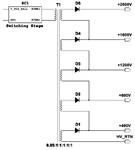vahid_ff
Newbie level 6

- Joined
- Oct 20, 2009
- Messages
- 12
- Helped
- 0
- Reputation
- 0
- Reaction score
- 0
- Trophy points
- 1,281
- Location
- Virginia, USA
- Activity points
- 1,404
Hi there,
In my new project, I need to design and built a digitally programmable power supply. The specs are as below:
* Vout max = 2 KV
* I out max < 2 mA (1 mA is OK)
* Resolution: 10 Volt
* The output should be fast enough to change within few hundred milliseconds.
The linear approach (Bulky high voltage transformers etc) seems to be not applicable here.
Any suggestion is appreciated.
In my new project, I need to design and built a digitally programmable power supply. The specs are as below:
* Vout max = 2 KV
* I out max < 2 mA (1 mA is OK)
* Resolution: 10 Volt
* The output should be fast enough to change within few hundred milliseconds.
The linear approach (Bulky high voltage transformers etc) seems to be not applicable here.
Any suggestion is appreciated.





